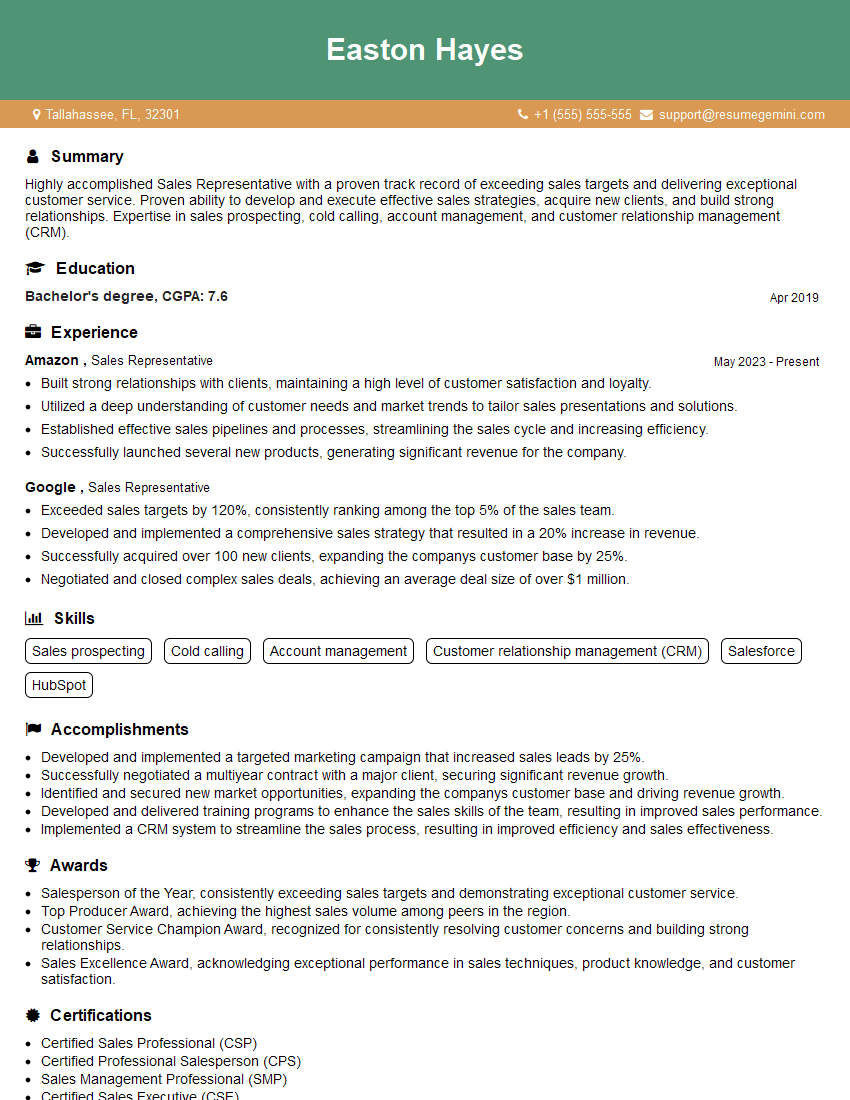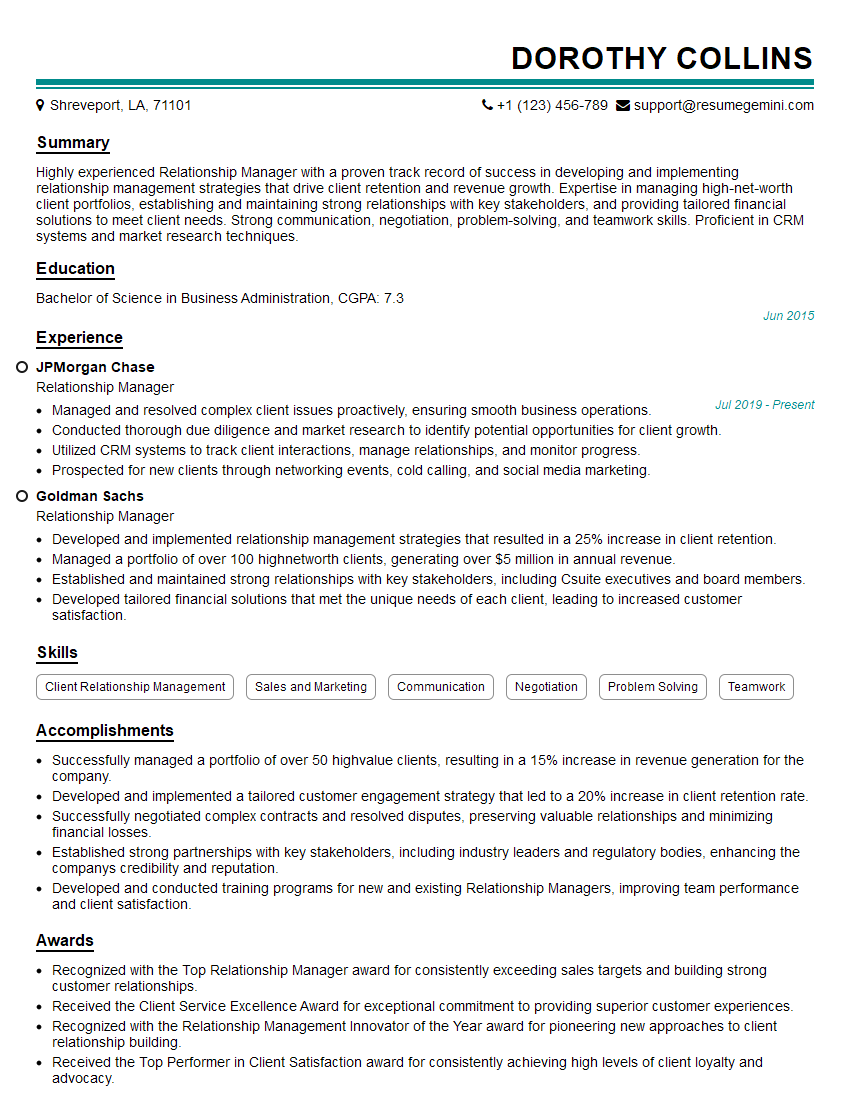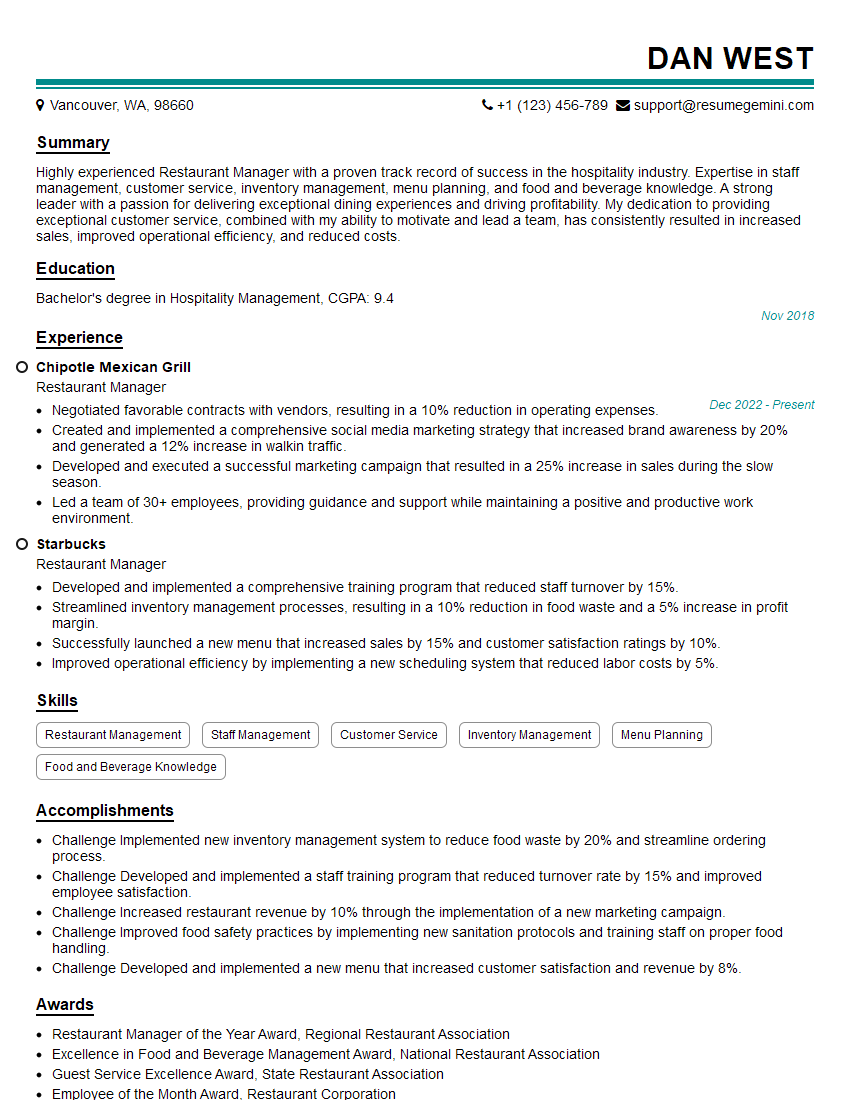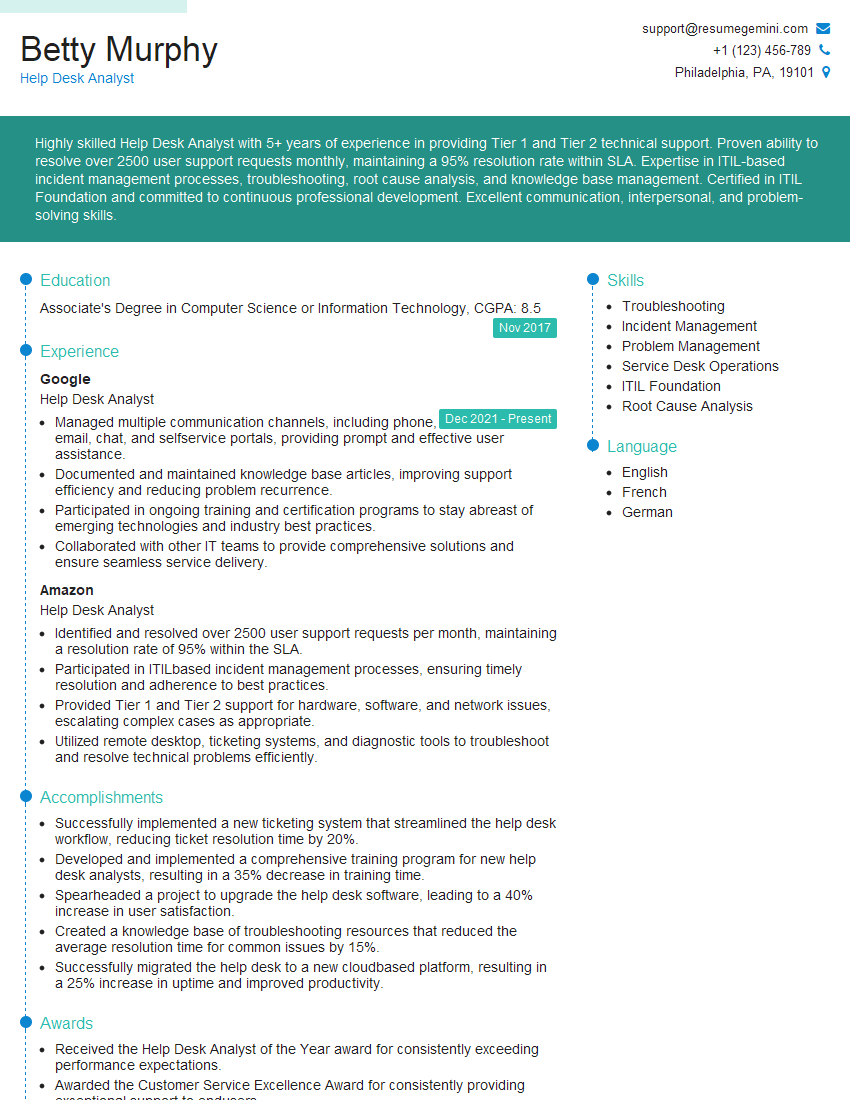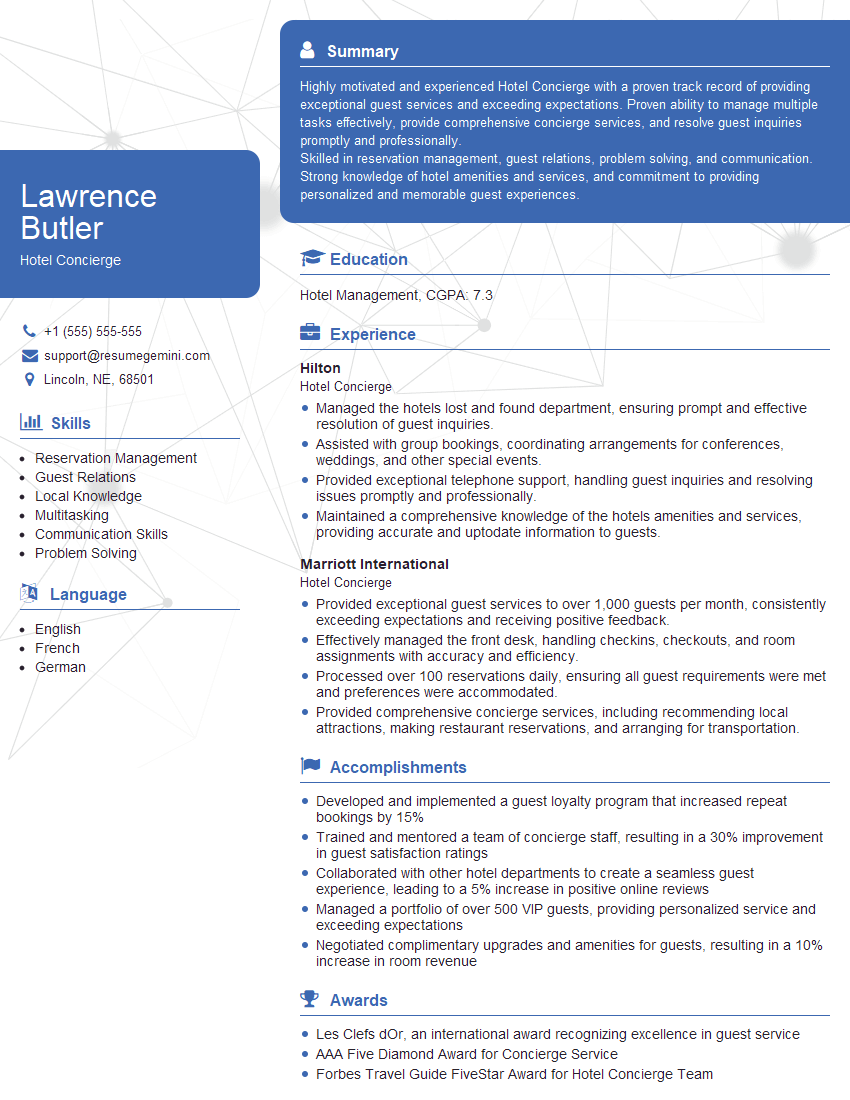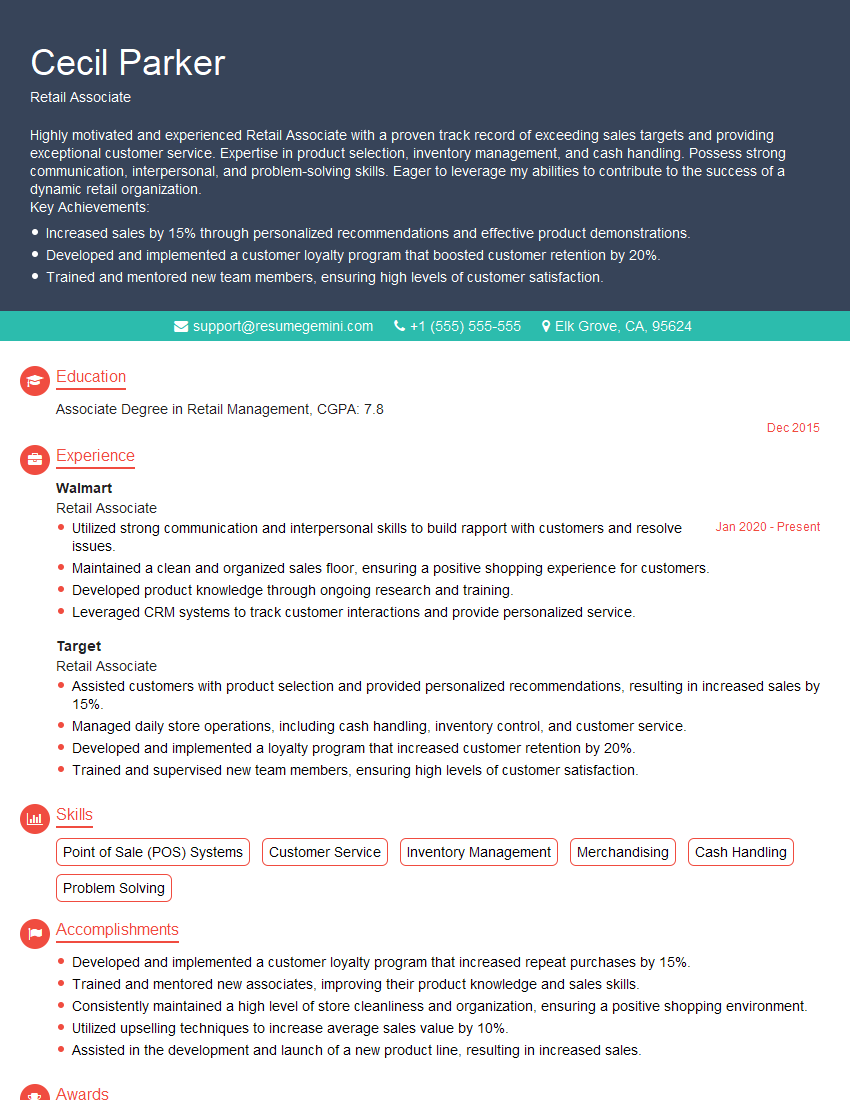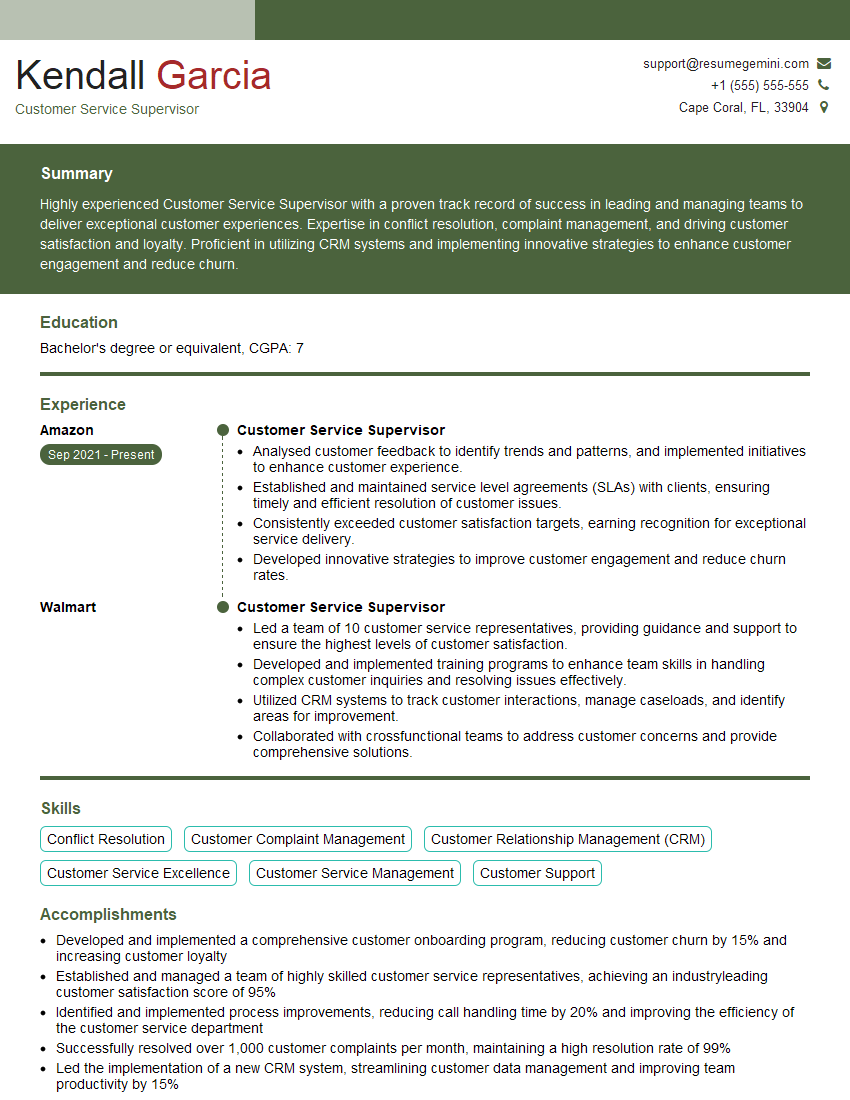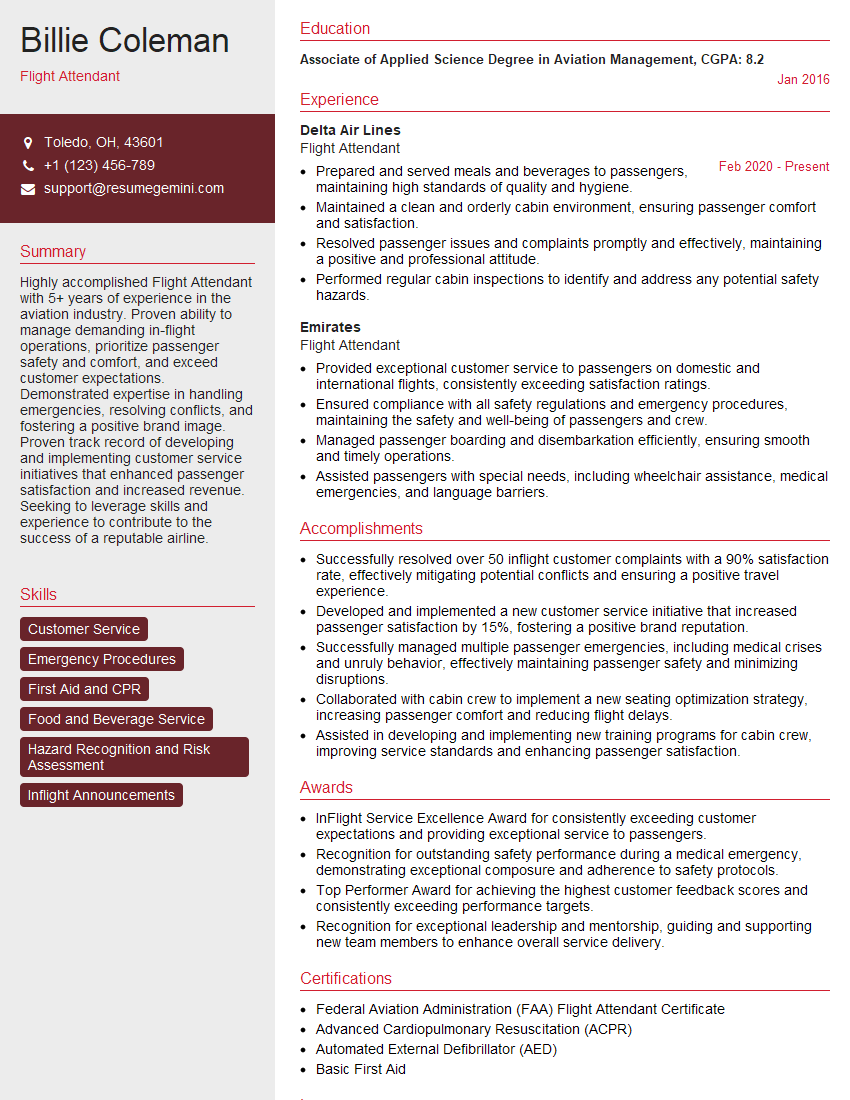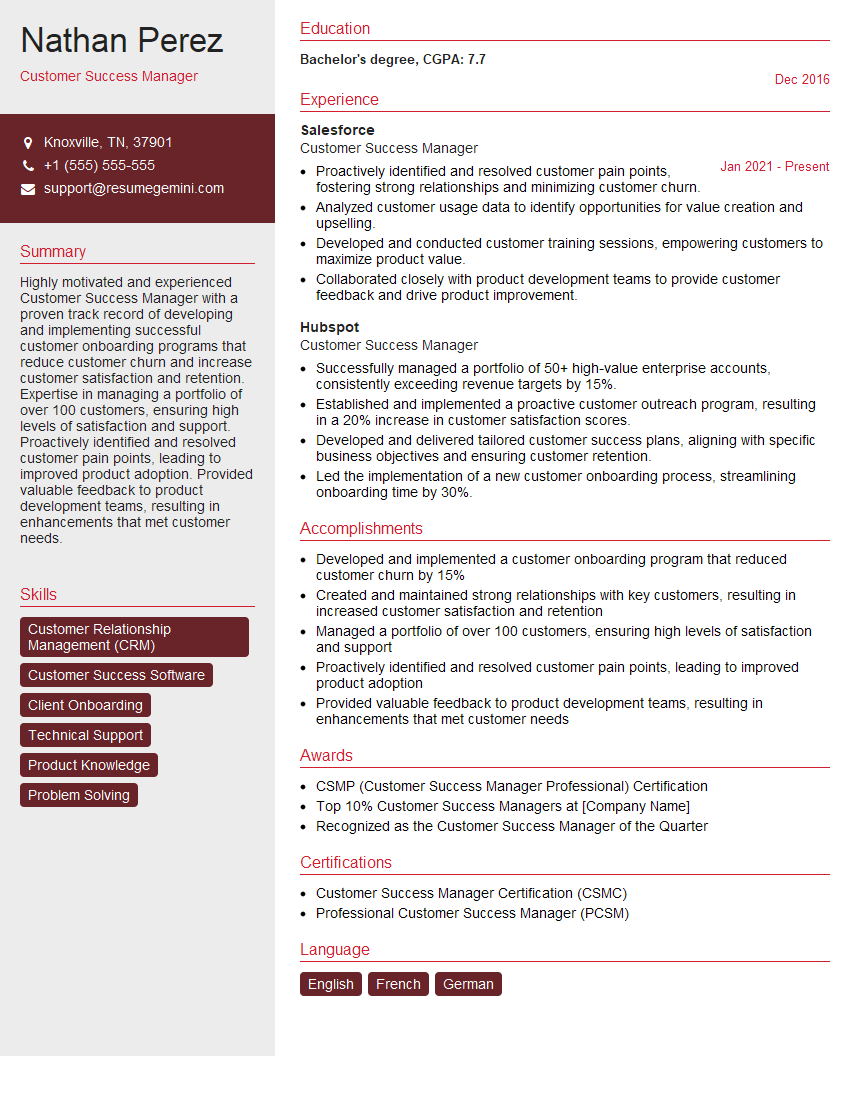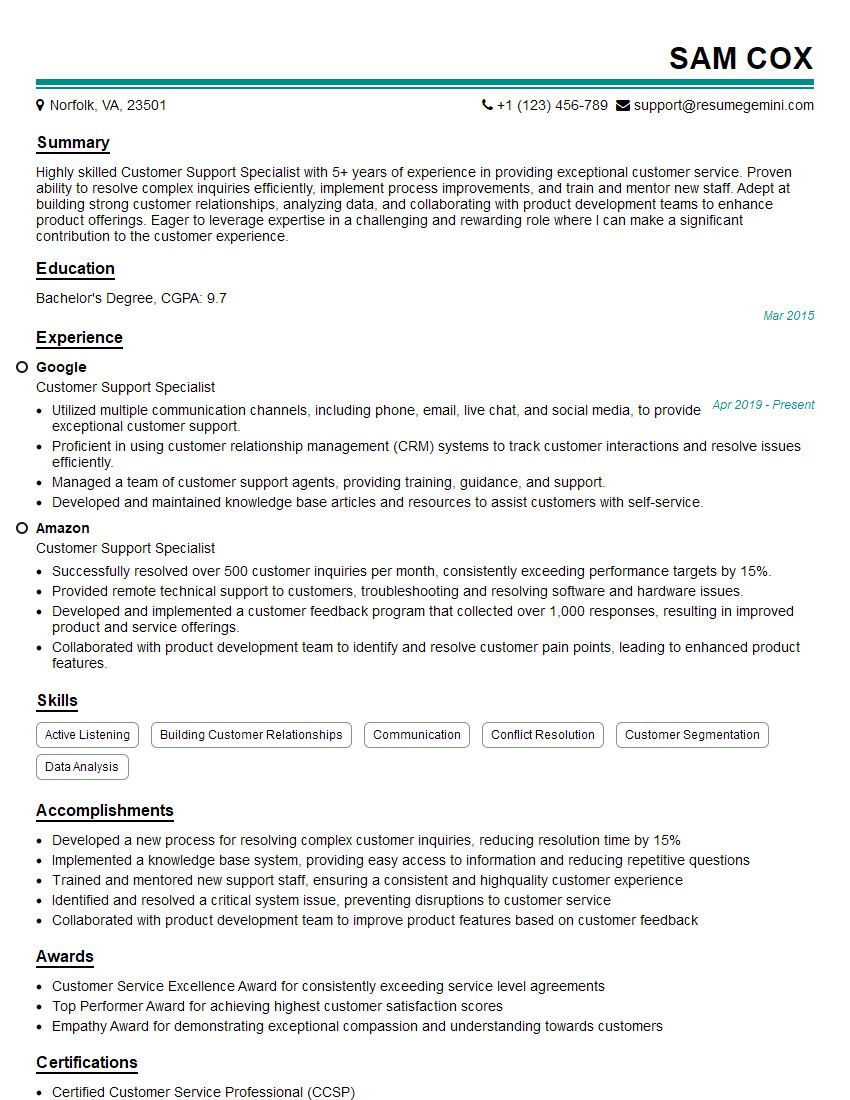Cracking a skill-specific interview, like one for Handling Difficult Customers with Professionalism, requires understanding the nuances of the role. In this blog, we present the questions you’re most likely to encounter, along with insights into how to answer them effectively. Let’s ensure you’re ready to make a strong impression.
Questions Asked in Handling Difficult Customers with Professionalism Interview
Q 1. Describe your approach to de-escalating a tense situation with an angry customer.
My approach to de-escalating a tense situation with an angry customer centers around empathy, active listening, and a calm, controlled demeanor. Think of it like this: you’re trying to diffuse a bomb, not add fuel to the fire.
- Active Listening: I start by letting the customer fully express their frustration without interruption. I use verbal and non-verbal cues like nodding and maintaining eye contact to show I’m engaged. This allows them to feel heard and understood, which often reduces their anger.
- Empathy and Validation: Once they’ve finished, I acknowledge their feelings. Phrases like, “I understand your frustration,” or “I can see why you’re upset,” go a long way. I avoid arguing or justifying the situation; instead, I focus on understanding their perspective.
- Controlled Response: I speak calmly and clearly, using a measured tone of voice. I avoid becoming defensive or argumentative. I might say something like, “Let’s work together to find a solution.”
- Find Common Ground: I identify areas of agreement to build rapport and cooperation. This might involve acknowledging the inconvenience or difficulty the situation caused.
- Offer a Solution: Once the customer feels heard and understood, I present potential solutions. I offer options and involve them in the decision-making process.
For example, if a customer is angry about a delayed shipment, instead of becoming defensive about the company’s shipping policy, I’d start by saying, “I understand this delay is frustrating, and I apologize for the inconvenience.” Then, I’d explore options like expedited shipping or a refund.
Q 2. How do you handle a customer who is consistently unreasonable and demanding?
Handling consistently unreasonable and demanding customers requires a firm yet professional approach. The key is setting boundaries while maintaining empathy. You can’t please everyone, and sometimes you have to protect yourself and your colleagues from abusive behavior.
- Set Clear Boundaries: Politely but firmly communicate acceptable behavior. For instance, “I understand your concerns, but I can’t tolerate disrespectful language.”
- Document Everything: Keep a detailed record of interactions, including the date, time, nature of the complaint, and the actions taken. This is crucial for protecting yourself and the company.
- Involve a Supervisor: If the customer’s behavior remains unreasonable and escalates despite your best efforts, it’s essential to involve a supervisor or manager. They may have more authority or experience to handle the situation.
- End the Conversation: In extreme cases where the customer is abusive or threatening, you have the right to end the conversation. Explain that you’re unable to continue the discussion if respectful communication isn’t maintained. Offer alternate contact methods, such as email or a call back from a manager.
For example, if a customer repeatedly demands impossible concessions, I might say, “I understand you’re unhappy, but I can’t fulfill this request. However, I can offer you these alternatives.” If the behavior persists, I would escalate the issue to my supervisor.
Q 3. What techniques do you use to empathize with a frustrated customer?
Empathizing with a frustrated customer is crucial for de-escalation. It’s not about agreeing with their every point, but understanding their feelings and perspective. It’s about showing you care.
- Active Listening: Paying close attention to what they say, both verbally and non-verbally, helps understand their emotional state.
- Reflecting Feelings: Use phrases that acknowledge their feelings. For example, “It sounds like you’re really feeling disappointed,” or “I can hear how frustrating this has been for you.”
- Validating their Experience: Acknowledge the legitimacy of their feelings, even if you don’t agree with the reason for their frustration. A simple “I understand why you feel that way” can make a significant difference.
- Using Mirroring: Subtly mirroring their body language (but not mockingly!) can create a subconscious connection, promoting empathy.
For example, if a customer is upset because a product is defective, I might say, “I understand your frustration. Receiving a faulty product is certainly disappointing, and I’ll do everything I can to resolve this for you.”
Q 4. How do you identify the root cause of a customer’s complaint?
Identifying the root cause of a customer’s complaint goes beyond simply hearing their words; it requires digging deeper to understand the underlying issue. Think of it like a detective investigating a crime scene.
- Ask Open-Ended Questions: Instead of yes/no questions, ask open-ended questions like, “Can you tell me more about what happened?” or “What were you hoping to achieve?” This encourages the customer to elaborate and reveal the true source of their dissatisfaction.
- Listen Carefully to the Details: Pay close attention to the specific details the customer shares. Often, the underlying issue isn’t explicitly stated but implied in their description.
- Summarize and Confirm Understanding: To make sure you’re on the same page, summarize the customer’s concerns and ask if you’ve understood correctly. This helps clarify any misunderstandings.
- Consider Contextual Factors: Think about external factors that may be contributing to the customer’s complaint. For example, a delay in delivery due to bad weather is not the fault of the company, but it explains the customer’s frustration.
For instance, if a customer complains about a slow website, it might be due to a server issue, a user’s internet connection, or even just poor website design. By asking clarifying questions and listening carefully, I can determine the actual source of the problem.
Q 5. Explain a time you had to apologize to a customer. What was the outcome?
I once had to apologize to a customer for a miscommunication regarding a return policy. The customer had attempted a return outside the specified timeframe and was understandably upset when their return was initially refused. I reviewed the situation, found that indeed there had been an oversight in our initial communication, and apologized sincerely for the error.
I explained the situation and why there was a misunderstanding. I then offered a solution that satisfied the customer — a full refund even though they technically did not meet the return window.
The outcome was positive. The customer appreciated the apology and the resolution. It reinforced their trust in our company and they remain a loyal customer.
Q 6. How do you maintain composure and professionalism when dealing with abusive customers?
Maintaining composure and professionalism with abusive customers is paramount. It’s crucial to remember that their behavior reflects their own issues, not a personal attack on you. Think of it as a performance: you are the calm professional in a difficult situation.
- Stay Calm and Neutral: Avoid getting drawn into an argument. Respond calmly and professionally, even when provoked.
- Use De-escalation Techniques: Employ techniques like active listening, empathy, and validating their feelings (without necessarily agreeing with them). This can help diffuse their anger.
- Set Boundaries: Politely but firmly communicate that abusive behavior is unacceptable. You might say, “I understand your frustration, but I can’t tolerate this type of language.”
- Remove Yourself (if Safe): If the situation becomes unsafe or excessively abusive, remove yourself from the interaction and seek help from a supervisor or security personnel.
- Document Everything: Detailed documentation of the interaction is essential for your protection and for potential disciplinary action against the customer.
By remaining calm and professional, you demonstrate self-control and allow the situation to de-escalate, preventing further conflict and protecting both the company’s image and your own well-being.
Q 7. Describe your experience using active listening skills to resolve a customer issue.
Active listening played a vital role in resolving an issue with a customer who experienced a billing error. Initially, the customer was extremely agitated, and their tone was sharp. Instead of interrupting or immediately jumping to solutions, I employed active listening skills.
I listened intently to their account of the problem, repeating key points to confirm my understanding (“So, if I understand correctly, you were billed twice for the same service… “). I used non-verbal cues like nodding and maintaining eye contact to show I was fully present and focused on their problem.
By actively listening and repeating their statements to show I fully understood, I built trust. This allowed the customer to feel heard and validated. It reduced their anger significantly. Once their emotional level subsided, we were able to work through the billing issue effectively and efficiently, leading to a positive resolution and a satisfied customer.
Q 8. How do you handle situations where you cannot immediately resolve a customer’s problem?
When I can’t immediately resolve a customer’s problem, my priority is to manage expectations and keep them informed. This involves acknowledging their frustration, empathizing with their situation, and providing a clear timeline for resolution. I don’t make promises I can’t keep. Instead, I offer realistic estimates based on what I know is possible given the available resources and processes.
For example, if a technical issue requires escalation to a specialist team, I’ll explain the process, the likely timeframe (e.g., “Our specialist team typically responds within 24 hours. I’ll follow up with you by the end of the day to give you an update.”), and offer a way for them to check the status of their request (e.g., a ticket number, a link to an online tracking system). I’ll also ensure I capture all relevant details accurately to ensure a smooth handoff to the appropriate team.
This proactive approach minimizes the risk of escalating frustration. Maintaining open communication is key, including regular updates even if there’s no immediate progress. This shows the customer that I’m actively working on their behalf and reduces the perception of neglect.
Q 9. What strategies do you employ to prevent customer conflicts from escalating?
Preventing escalation involves active listening, empathy, and a proactive approach. I start by letting the customer fully express their concerns without interruption. This allows me to understand the root cause of their dissatisfaction. I then actively listen for their emotional cues, acknowledging and validating their feelings, even if I don’t necessarily agree with their perspective. For example, saying something like, “I understand your frustration; this is certainly not the experience we want for our customers.” can make a big difference.
Next, I clearly explain the steps I’m taking to address their concern, offering concrete solutions. I avoid arguing or becoming defensive. My focus remains on finding a mutually acceptable solution. If necessary, I’ll suggest alternative solutions or compromises. I might offer a small concession as a gesture of goodwill, depending on the situation and company policy. Throughout the interaction, I maintain a calm and professional demeanor, speaking clearly and slowly, avoiding jargon.
If the conversation is becoming heated, I might suggest a short break to allow both of us to compose ourselves. This can often de-escalate the situation and allows for a more productive conversation when we resume.
Q 10. How do you determine the appropriate level of authority needed to resolve a customer issue?
Determining the appropriate level of authority involves assessing the nature and complexity of the issue. Simple issues, such as a refund for a faulty product within company guidelines, can often be resolved at my level. However, more complex issues – for instance, a significant billing discrepancy, a request for a policy exception, or a complaint involving a legal matter – might require escalation.
I consider several factors: the financial impact, the potential reputational damage, and the customer’s level of distress. If I’m unsure about my authority, I will err on the side of caution and seek guidance from my supervisor before making a decision. Transparency is key. If escalation is necessary, I clearly explain the reason to the customer, providing reassurance that their issue is being handled promptly.
Q 11. Have you ever had to involve a supervisor in a difficult customer interaction? Explain the circumstances.
I once had to involve my supervisor when a customer refused to accept a reasonable solution for a damaged product. The customer had received a damaged item, and despite providing them with several options (a full refund, a replacement, or a significant discount), they insisted on a completely unreasonable compensation beyond our company’s policy. They became increasingly aggressive and verbally abusive.
After attempting various de-escalation tactics, I felt it was necessary to involve my supervisor for several reasons: to ensure fairness and consistency in application of company policy, to document the situation thoroughly, and to protect myself from further verbal abuse. My supervisor acted as a mediator, calmly reiterating company policy while demonstrating empathy and respect for the customer’s experience. While the customer still wasn’t satisfied, the situation was de-escalated and handled appropriately and professionally.
Q 12. How do you balance meeting customer needs with company policy?
Balancing customer needs with company policy requires careful navigation and excellent communication. My goal is to find solutions that both satisfy the customer and uphold the company’s regulations. This often involves explaining the company policy clearly, respectfully, and in a way that the customer can understand. I aim to find the greatest possible flexibility allowed within those guidelines. For instance, if a customer requests a return outside of the standard return window, I will explain the policy while exploring any exceptions the company might offer (e.g., extenuating circumstances).
If a compromise isn’t possible within company policy, I will clearly explain why, offering alternative solutions where feasible. I ensure transparency, explaining my actions and the reasoning behind my decisions. This builds trust and demonstrates my commitment to fairness, even when the desired outcome cannot be achieved. The approach is about finding solutions that are both fair and within the bounds of our established policies.
Q 13. How do you handle situations where a customer is making unreasonable demands?
Handling unreasonable demands requires a firm yet empathetic approach. I begin by actively listening, acknowledging their concerns, and attempting to understand the underlying issue behind the unreasonable request. It’s possible there’s a deeper concern or misunderstanding. Then I reiterate company policy in a clear and concise manner, explaining why the request cannot be met. I use calm and neutral language, avoiding arguments or defensiveness.
If the customer continues to make unreasonable demands, I maintain a professional distance but reiterate the limits of what’s possible. I may offer alternative solutions or compromises that are within reason. If the situation becomes abusive or threatening, I will politely but firmly end the conversation and involve my supervisor. The key is to set boundaries while remaining respectful and professional; maintaining professionalism shows respect for the customer while upholding company policies and standards.
Q 14. How do you handle customer complaints via phone, email, and in person?
My approach to handling customer complaints remains consistent across all channels (phone, email, in-person), focusing on active listening, empathy, and efficient resolution.
- Phone: I use a clear and calm tone, ensuring I understand the complaint thoroughly. I confirm details, offer apologies if appropriate, and provide updates regularly.
- Email: I respond promptly, acknowledging the complaint and outlining the steps to resolve it. I maintain a professional and courteous tone. I avoid using overly informal language.
- In-person: I establish eye contact, use active listening techniques, and employ non-verbal cues to show empathy. I offer solutions and follow up promptly in writing.
Regardless of the channel, I always strive to document the interaction carefully, including the customer’s contact information, a detailed description of the complaint, the steps taken to resolve it, and the outcome. This comprehensive documentation aids in effective tracking, efficient future resolution and protects both the customer and the company.
Q 15. What is your process for documenting difficult customer interactions?
My process for documenting difficult customer interactions is meticulous and follows a standardized format to ensure clarity, accountability, and consistent record-keeping. This is crucial for both internal learning and potential future reference.
- Immediately after the interaction: I create a detailed note summarizing the key points of the conversation, including the customer’s name, contact information, the issue at hand, the steps taken to resolve it, and the outcome. I make sure to record the customer’s specific concerns and their emotional state (e.g., frustrated, angry, upset). This helps paint a complete picture of the interaction.
- Objective Language: I avoid subjective or emotional language, focusing instead on factual details and the actions undertaken. For instance, instead of writing “The customer was furious,” I’d write “The customer raised their voice and expressed strong dissatisfaction with…”
- Systemic Recording: I utilize our company’s CRM or ticketing system to document the interaction, ensuring it’s readily accessible to other team members who may need to follow up. This allows for seamless transitions and avoids repetition of effort.
- Follow-up Notes: If further action is required, I add follow-up notes to track the progress of the resolution. This may include dates and times of any subsequent calls, emails, or actions taken.
This comprehensive approach guarantees clear communication and allows for better understanding and analysis of customer interactions, identifying trends and areas for improvement in customer service strategies. It’s all about building a solid record that protects both the customer and the company.
Career Expert Tips:
- Ace those interviews! Prepare effectively by reviewing the Top 50 Most Common Interview Questions on ResumeGemini.
- Navigate your job search with confidence! Explore a wide range of Career Tips on ResumeGemini. Learn about common challenges and recommendations to overcome them.
- Craft the perfect resume! Master the Art of Resume Writing with ResumeGemini’s guide. Showcase your unique qualifications and achievements effectively.
- Don’t miss out on holiday savings! Build your dream resume with ResumeGemini’s ATS optimized templates.
Q 16. Describe a situation where you went above and beyond to satisfy a difficult customer.
During a particularly busy holiday season, a customer’s order was significantly delayed due to unforeseen logistical issues beyond our control. The customer, understandably, was extremely upset and felt their holiday plans were jeopardized. While I empathized with their frustration, I knew simply apologizing wasn’t enough.
I went above and beyond by first sincerely acknowledging their disappointment and taking full ownership of the situation, avoiding any blame shifting. I then proactively offered several solutions: expedited shipping at no extra cost (which involved coordinating with our shipping partners), a significant discount on their next purchase, and a complimentary gift as a token of our apology. I kept them updated every step of the way about the order’s status.
Ultimately, the customer was incredibly grateful for my proactive problem-solving and the personal touch. They not only received their order in time but also expressed their renewed faith in our company. This situation reinforced my belief that exceeding expectations during a challenging time strengthens customer relationships and builds loyalty.
Q 17. How do you handle a situation where a customer is being verbally abusive?
Handling verbal abuse requires a calm and professional approach, prioritizing de-escalation and self-preservation. My priority is always safety—both mine and that of others.
- Remain Calm and Professional: I would not engage in a shouting match. My demeanor would remain calm and respectful, even if the customer is not.
- Active Listening (to an extent): While listening for key information about the source of their anger, I wouldn’t let the abuse continue unchecked. I’d actively try to steer the conversation toward finding a solution.
- Set Boundaries: I would clearly state that abusive language is unacceptable and that I am prepared to end the conversation if it continues. For instance, I might say, “I understand you’re upset, but I cannot continue this conversation if you continue to use abusive language.”
- Offer a Solution (if possible): If the abuse subsides, I would attempt to offer solutions or alternative contact methods.
- Document Everything: A thorough record of the interaction, including the abusive language used, is essential for our company’s record and for my own safety.
- Seek Support: If the situation escalates or feels unsafe, I would immediately seek assistance from a supervisor or security personnel. My safety is paramount.
Ultimately, my goal is to de-escalate the situation, document the interaction appropriately, and protect myself. While I strive for customer satisfaction, my personal safety cannot be compromised. This is not about winning an argument but about maintaining a professional and safe environment.
Q 18. How do you ensure customer satisfaction while adhering to company procedures?
Balancing customer satisfaction with company procedures requires a delicate yet achievable equilibrium. It’s about finding creative solutions within the established framework.
- Understand Company Policies: I thoroughly understand our company’s policies, procedures, and limitations. This allows me to anticipate potential challenges and tailor my responses accordingly.
- Communicate Clearly and Honestly: I communicate transparently with customers about company policies and any limitations they might encounter. Honesty builds trust, even if the news is not what the customer hoped for.
- Seek Alternatives within Policy: I explore all possible solutions within the established parameters. This might involve bending the rules slightly (if possible and permitted by supervisors) or finding creative ways to meet customer needs without violating company policy. This shows that I’m working with them, not against them.
- Escalate Appropriately: If a customer’s request falls outside company policy, I escalate the matter to my supervisor, clearly explaining the situation and potential solutions, including the risk of losing the customer and the benefit of going the extra mile. Collaboration ensures we find the best resolution.
- Document Everything: I meticulously document each interaction, including the customer’s request, the steps taken, and any decisions made. This ensures accountability and protects both the company and myself.
Finding this balance is key to building long-term customer relationships while ensuring the company’s policies and procedures are respected.
Q 19. How do you manage your stress level when dealing with multiple difficult customers?
Managing stress when dealing with multiple difficult customers requires proactive strategies focused on self-care and effective time management.
- Prioritization: I prioritize calls and address urgent issues first. This minimizes wait times and reduces overall stress.
- Time Management: I utilize time-blocking techniques and short breaks between calls to prevent burnout. These short mental respites help me maintain focus and professionalism.
- Deep Breathing and Mindfulness Techniques: I utilize deep breathing exercises or short mindfulness practices between calls to help manage my stress levels. A few minutes of focused breathing can significantly impact stress reduction.
- Positive Self-Talk: I engage in positive self-talk to maintain a positive mindset. This reminds me of my capabilities and helps me approach each interaction with confidence.
- Teamwork: I don’t hesitate to ask for help or to collaborate with colleagues when necessary. Sharing the workload reduces individual stress.
- After-work Routine: I ensure I have a dedicated time to unwind and decompress after work to avoid bringing work stress home.
Managing stress is an ongoing process. By proactively implementing these strategies, I maintain my composure, effectiveness, and overall well-being even during high-pressure situations.
Q 20. How do you prioritize customer requests during peak periods?
Prioritizing customer requests during peak periods requires a structured approach that combines efficiency with empathy.
- Urgent vs. Routine: I categorize requests based on urgency. Urgent requests—those requiring immediate attention, such as critical system failures or security breaches—take precedence. Routine requests can be handled efficiently in a later time slot.
- First-Come, First-Served (with exceptions): In general, I follow a first-come, first-served system for incoming requests. However, I make exceptions for urgent situations, ensuring that the most critical needs are addressed swiftly.
- Clear Communication: I keep customers informed about potential wait times, managing their expectations. Honest communication can prevent unnecessary frustration.
- Workflow Optimization: I ensure my workspace is organized and I have all the necessary tools ready to quickly address customer issues. This minimizes downtime and enhances efficiency.
- Teamwork and Support: During peak periods, I collaborate with my team, distributing requests to ensure workload balance and reduce individual stress.
The key during peak periods is effective organization and clear communication, ensuring the most critical needs are met promptly while maintaining fair treatment for all.
Q 21. Describe a time you had to make a difficult decision related to a customer’s request.
I once had to make a difficult decision concerning a customer’s request for a full refund on a product that was damaged due to misuse, after the return window had closed. The company policy was clear—no refunds after the return period.
However, the customer provided compelling evidence demonstrating they had followed all instructions and the damage was a manufacturing defect, not misuse as our initial assessment suggested. After careful review of the evidence and consultation with my supervisor, I decided to approve a full refund, despite being outside of company policy. This decision prioritized customer satisfaction and retained a loyal customer who felt heard and valued.
While it deviated from standard procedure, this decision was made based on a thorough evaluation of the circumstances and demonstrated my commitment to fairness and proactive problem-solving. Transparency and clear communication with my supervisor were key in making this decision. The overall benefit of retaining a loyal customer far outweighed the risk associated with this exception to the policy. It reinforced the importance of making evidence-based decisions, prioritizing ethical treatment of our customers, and taking ownership of resolution even when it requires deviation from standard operating procedures.
Q 22. How do you identify and address customer expectations that are unrealistic?
Identifying and addressing unrealistic customer expectations requires a delicate balance of empathy and firmness. It starts with active listening to understand the root of their expectation. Is it a misunderstanding of our services, a misinterpretation of marketing materials, or an outright unreasonable demand? Once identified, I employ a structured approach:
- Validate their feelings: Begin by acknowledging their concerns and showing empathy. Phrases like, “I understand your frustration,” or, “I can see why you’d expect that,” go a long way.
- Clearly explain limitations: Gently but firmly explain why their expectation isn’t feasible. Use clear, concise language, avoiding jargon. For example, “While we strive for perfection, our current systems don’t allow for same-day delivery for this type of order.”
- Offer alternative solutions: Propose realistic alternatives that meet some of their needs. This demonstrates your willingness to help, even if you can’t fulfill their original request. Perhaps a faster shipping option, a discount on a future order, or a referral to a service that can provide what they need.
- Set clear expectations: Reinforce what is achievable and within the realm of possibility. This prevents future misunderstandings and sets a realistic foundation for the interaction.
Example: A customer expects a full refund on a custom-made product despite accepting the terms and conditions, which clearly state no refunds on custom orders. I would empathize with their dissatisfaction, explain the company policy clearly, and offer a partial refund or a discount on their next order as a gesture of goodwill.
Q 23. What is your understanding of customer relationship management (CRM)?
Customer Relationship Management (CRM) is a technology for managing all your company’s relationships and interactions with customers and potential customers. The goal is simple: improve business relationships. A good CRM system helps businesses stay connected to customers, streamline processes, and improve profitability.
My understanding encompasses various aspects:
- Data Management: A CRM stores comprehensive customer data – contact information, purchase history, interactions, and preferences – providing a holistic view of each customer.
- Sales Automation: It automates tasks like lead generation, follow-up, and sales reporting, freeing up time for more strategic activities.
- Marketing Automation: Targeted marketing campaigns and personalized communications can be executed more efficiently.
- Customer Service Enhancement: Improved tracking of customer interactions and issue resolution significantly enhances customer service.
- Reporting and Analytics: CRMs offer insightful reporting and analytics, helping businesses understand customer behavior and improve strategies.
I’m proficient in using several CRMs, including Salesforce, HubSpot, and Zoho CRM. My experience includes data entry, report generation, and leveraging CRM features to improve customer engagement and satisfaction.
Q 24. How proficient are you in conflict resolution techniques?
I’m highly proficient in conflict resolution techniques. My approach is based on active listening, empathy, and a structured problem-solving process. I believe in finding win-win solutions whenever possible.
My skillset includes:
- Active Listening: I pay close attention to both the verbal and nonverbal cues of the customer, ensuring I fully understand their perspective.
- Empathy: I try to understand the customer’s feelings and perspective, even if I don’t agree with them.
- De-escalation: I use calming language and techniques to de-escalate tense situations. This might involve acknowledging their frustration, validating their feelings, and taking ownership of the problem where appropriate.
- Finding Common Ground: I focus on finding common goals to build a collaborative relationship with the customer.
- Problem-Solving: I use a structured approach to identify the root cause of the conflict, propose solutions, and reach an agreement.
- Mediation (if necessary): If I can’t resolve the issue alone, I’m comfortable involving a supervisor or other appropriate personnel.
Example: In a past role, I successfully de-escalated a situation with an angry customer who was upset about a delayed shipment by actively listening to their concerns, apologizing for the inconvenience, and offering a generous discount and expedited shipping for their next order.
Q 25. Describe your experience with different customer service software and tools.
I have extensive experience with a range of customer service software and tools. My proficiency spans various platforms and functionalities. Here are some key examples:
- CRM systems (Salesforce, HubSpot, Zoho CRM): I’m comfortable with data entry, reporting, and utilizing features to improve customer engagement.
- Help Desk/Ticketing Systems (Zendesk, Freshdesk, Jira Service Desk): I’m experienced in managing tickets, prioritizing issues, and tracking resolution times.
- Live Chat Software (Intercom, Drift): I’m proficient in using live chat platforms to provide immediate assistance and address customer queries in real-time.
- Email Management Tools (Gmail, Outlook): I use these tools effectively for managing customer correspondence, ensuring prompt and professional responses.
- Knowledge Base Systems: I’m familiar with using and contributing to knowledge bases to improve self-service options for customers.
My experience extends beyond individual tools; I’m adept at integrating various platforms to create a seamless customer experience. I understand the importance of efficient workflow and leveraging technology to maximize productivity and customer satisfaction.
Q 26. How would you handle a situation where a customer is threatening legal action?
Handling a customer threatening legal action requires a calm and professional approach, prioritizing documentation and escalation. My steps would be:
- Remain calm and professional: Avoid escalating the situation with defensive language or emotional responses. Maintain a respectful tone throughout the conversation.
- Document everything: Meticulously record all communications, including the customer’s threats, my responses, and any witnesses. This documentation is crucial for legal purposes.
- Listen and gather information: Actively listen to the customer’s concerns and try to understand their perspective, even if their claims seem unfounded.
- Offer a sincere apology (if appropriate): Even if you don’t agree with the customer’s assessment of the situation, a sincere apology for any inconvenience or perceived wrongdoing can go a long way in de-escalating the situation.
- Follow company protocol: Immediately escalate the situation to your supervisor or legal department. They will guide you on the appropriate actions to take, which may include referring the matter to legal counsel.
- Avoid making promises or admissions of guilt: Do not admit fault or make promises you cannot keep. Refer the customer to the appropriate channels for handling their legal concerns.
The key is to remain professional, document everything meticulously, and promptly escalate the situation to the appropriate authorities within the company.
Q 27. How do you deal with customers who are unfamiliar with technology or processes?
Dealing with customers unfamiliar with technology or processes requires patience, clear communication, and a willingness to adjust your approach. I employ several strategies:
- Use simple language: Avoid jargon and technical terms. Explain things in plain language, using analogies and examples to illustrate concepts.
- Break down complex tasks: Instead of overwhelming them with a lengthy process, break it down into smaller, manageable steps. Provide clear instructions for each step.
- Offer multiple communication channels: Recognize that some customers might prefer phone support over email or online chat. Be flexible and offer the channel that best suits their comfort level.
- Provide visual aids: Use diagrams, screenshots, or videos to supplement your explanations, particularly for technical processes.
- Be patient and understanding: Remember that not everyone is tech-savvy. Show empathy and patience in guiding them through the process.
- Offer additional support: Consider providing printed instructions, offering to walk them through the process step-by-step over the phone, or even scheduling a time to meet in person if feasible.
Example: An elderly customer struggled to use our online portal. Instead of assuming they understood the instructions, I offered to guide them through the process over the phone, explaining each step clearly and patiently. I also emailed them a simplified, step-by-step guide with screenshots.
Q 28. How do you handle a customer who refuses to cooperate or follow company policy?
Handling a customer who refuses to cooperate or follow company policy requires a firm yet respectful approach. The goal is to de-escalate the situation while upholding company policies and maintaining professionalism.
My strategy would include:
- Remain calm and professional: Avoid getting into an argument. Maintain a respectful and neutral tone.
- Clearly reiterate company policy: Calmly explain the relevant policy, using clear and concise language. Provide specific examples if necessary.
- Listen to their concerns: Even if they’re not cooperating, try to understand their underlying concerns. This might reveal the root cause of their resistance.
- Offer alternative solutions (if possible): If their objections are valid, see if you can offer a reasonable alternative that aligns with company policy.
- Document the interaction: Meticulously document the entire conversation, including the customer’s behavior and your responses.
- Escalate if necessary: If the customer continues to refuse cooperation or becomes abusive, escalate the situation to your supervisor. They will determine the appropriate course of action, which may include ending the interaction or taking further disciplinary measures.
The key is to balance firmness with respect. You need to maintain professionalism while upholding company policies, even in the face of uncooperative behavior. Escalation is sometimes necessary to protect both the company and other customers.
Key Topics to Learn for Handling Difficult Customers with Professionalism Interview
- Active Listening and Empathy: Mastering the art of truly understanding the customer’s perspective, even when frustrated, and responding with genuine empathy.
- De-escalation Techniques: Practical strategies for calming tense situations, using calming language and body language to diffuse anger and frustration. This includes identifying triggers and responding appropriately.
- Problem-Solving and Solution-Oriented Approaches: Focusing on finding practical solutions rather than getting bogged down in blame. This includes outlining steps to address the issue and managing customer expectations.
- Setting Boundaries and Maintaining Professionalism: Knowing when and how to firmly but politely address inappropriate behavior while still providing excellent service. This involves recognizing personal limits and maintaining composure.
- Communication Styles and Adaptability: Recognizing and adapting your communication style to match the customer’s needs and personality. Understanding different communication styles and tailoring your approach accordingly.
- Conflict Resolution Strategies: Employing effective techniques to navigate disagreements, finding common ground, and achieving mutually satisfactory outcomes. This includes negotiation and mediation skills.
- Documentation and Record Keeping: The importance of meticulously documenting interactions with difficult customers for future reference and to demonstrate a proactive approach to issue resolution.
- Self-Care and Stress Management: Recognizing the emotional toll of dealing with difficult customers and implementing strategies for stress management and self-care to maintain professional well-being.
Next Steps
Mastering the art of handling difficult customers with professionalism is paramount for career advancement in virtually any customer-facing role. It showcases crucial skills like communication, problem-solving, and emotional intelligence – highly valued by employers. To significantly boost your job prospects, crafting an ATS-friendly resume is essential. ResumeGemini is a trusted resource that can help you build a powerful resume that highlights your abilities in this critical area. We provide examples of resumes tailored to showcasing expertise in Handling Difficult Customers with Professionalism, allowing you to present your skills effectively to potential employers.
Explore more articles
Users Rating of Our Blogs
Share Your Experience
We value your feedback! Please rate our content and share your thoughts (optional).
What Readers Say About Our Blog
Hi, I’m Jay, we have a few potential clients that are interested in your services, thought you might be a good fit. I’d love to talk about the details, when do you have time to talk?
Best,
Jay
Founder | CEO

